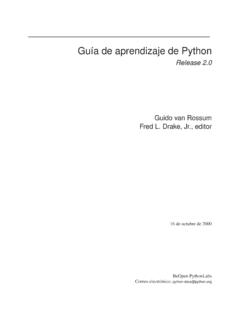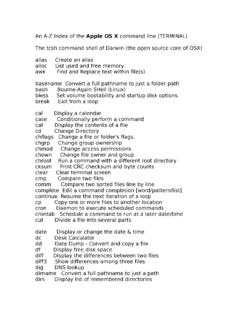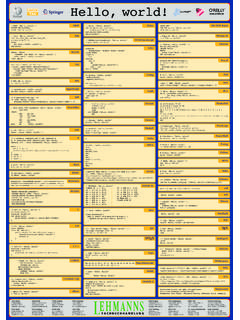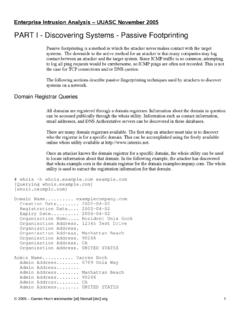Transcription of Monad12 Manifesto
1 Monad Manifesto 1 8/22/2002 Monad12 Manifesto Jeffrey P. Snover Aug 8, 2002 Version 1 What is Monad? Monad is the next generation platform for administrative automation. Monad solves traditional management problems by leveraging the .Net Platform. From our prototype (though limited), we can project significant benefits to developers, testers, power users, and administrators. Monad leverages the .NET Common Runtime to provide a powerful, consistent, intuitive, extensible and useful set of tools that drive down costs of administration and make the life of non-programmers a lot easier. Monad consists of: 1. Monad Automation Model (MAM): An automation model based upon .Net classes, methods and attributes to produce Cmdlets. 2. Monad Shell (MSH): A .Net based script execution environment for exposing Cmdlets as APIs command line tools and interactive programmable command line shell.
2 3. Monad Management Models (MMM): The set managed code base classes (or interfaces) to implement specific management scenarios and in-the-box administrative tools to execute those scenarios. 4. Monad Remote Scripting (MRS): A set of Web Service based components that allow scripts to be remotely executed on many machines. 5. Monad Management Console (MMC). A .Net based model and set of services for building management GUIs on top of MSH and exposing all GUI interactions as user-visible scripts. 1 This is not a Windows PowerShell whitepaper nor is it an accurate description of how works. This is a version of the original Monad Manifesto which articulated the long term vision and started the development effort which became PowerShell.
3 Many of the elements described in this document have been delivered and those that have not provide a good roadmap for the future. The document has been updated for publication. Confidential information has been culled and examples are updated to reflect the current syntax. 2 Monads are Leibniz s term for the fundamental unit of existence that aggregates into compounds to implement a purpose. In this philosophy, everything is a composition of Monads. This captures what we want to achieve with composable management. More information on Monadology can be found at: Monad Manifesto 2 8/22/2002 This whitepaper presents the traditional approach to administrative automation, its strengths and shortcomings. Monad s new approaches are then articulated. An overview of the major components of Monad is then presented.
4 A set of value propositions is then articulated for Monad s target audiences. 2 Problem Windows has simple GUI administrative tools for basic users (Control Panel, MMC, etc). Windows also has a rich set of languages, APIs and object models for advanced systems programmers (C, C++, C#, WMI, Win32, .Net, etc). What is missing is the vital middle administrator-oriented composable tools to type commands and automate management. The vital middle is typically addressed by scripting languages. Our current scripting solutions (WSH, VB) focus on the high end of the scripting world which manage the platform using very low level abstractions such as complex object models, schema, and APIs. This is effectively systems programming and misses much of the admin community.
5 Admin scripting flows from command line admininstration3, it must be small, simple, incremental, and deal with very high levels of abstraction. John Ousterhout described the distinction between scripting and systems programming well in his paper Scripting: Higher Level Programming for the 21st Century. StrongNoneDegree of TypingInstructions/StatementAssemblyCC++ C#System ProgrammingshVBMonadScripting1000s110s10 0s Ousterhout posits that scripting allows for gluing applications together a higher level abstraction than system programming enabling (even) more rapid application development than today s systems programming languages. The fundamental argument is that we should continue to ride Moore s Law to move development to higher levels of abstraction via script.
6 To enable administration automation in the mainstream, administrators need a comprehensive and scriptable shell and utilities and the administrative GUIs need to be layered on top of this infrastructure. This will enable efficient training of administrators on command line automation, ensure comprehensive administrative capabilities at the command line, and the economies of scale of an admin-composable automation model. 3 Admin scripting is often the progression from ad hoc scripts to automated operations. Admins notice that they type the same commands over and over again so they build a script. The notice that their scripts contain lots of the same things so they produce parameterized subroutines and progress from there.
7 Monad Manifesto 3 8/22/2002 3 The Traditional Approach to Administrative Automation The traditional model for administrative automation is powerful and successful. It consists of: 1. A programmatic shell ( sh, csh, ksh, bash) 2. A set of administrative commands ( ifconfig, ps, chmod, kill) 3. A set of text manipulation utilities ( awk, grep, sed). 4. Administrative GUIs layered on top of commands and utilities This model s philosophy is that every executable should do a narrow set of functions and complex functions should be composed by pipelining or sequencing executables together. This model has been extremely successful despite serious drawbacks. Upon inspection, what is widely considered a UNIX stronghold is in fact a flawed implementation of this model.
8 When you step back and examine what is really going on when someone uses a pipelined command like $ a | b | c , you conclude that the first command a did not accomplish what the admin wanted to do. If it had, the admin would have just type a and been done with it. So then the question is why didn t a do what the admin wanted? The answer is that in this traditional model, the stand-alone executables tightly bind three operations together: 1) getting objects; 2) processing objects; 3) outputting results as text. One of those operations does not do what the admin needs so the rest of the pipeline is an attempt to fix that. Because the executable outputs text, the downstream elements must use text manipulation utilities to try to get back to the original objects to do additional work.
9 While the basic model is extremely powerful, its intrinsic flaw is the tight binding of these operations and the use of unstructured text for integration. This requires clumsy, lossy, imprecise text manipulation utilities. The traditional model reflects the state of the technology that was available at the time it emerged..Net provides a new set of capabilities and opens up the possibility of new approaches. These new approaches allow us to replace the traditional model with a decisively superior one. That model is Monad. 4 New Approaches Monad takes new approaches to the issues of 1) building commands, 2) composing solutions 3) management models and 4) management GUIs. The Monad architecture flows from the following observations: 1. Most solutions are home brewed and composed out of existing commands by administrators.
10 2. Most solutions are focused on either automating management or providing ad hoc fixes. 3. Most administrators are para-programmers. They either don t have the desire, skill or (more often), the time to do sophisticated programming. 4. Most application developers won t make their code manageable unless there is immediate and substantial user benefit. A New Approach to Building Commands The traditional approach to building commands is inefficient. Much of the effort is spent rewriting the same functions over and over again by different people in different ways. They all: Parse, validate, and encode user input Document usage Monad Manifesto 4 8/22/2002 Log activity Format data, output results and report errors Operate on remote nodes or sets of remote nodes.



